From Beer to Highballs: An In-Depth Look at 5 Must-Try Beverages!
Step into a lively Japanese Izakaya (a casual Japanese pub), and you’ll be greeted by energetic shouts of “Irasshaimase!” (Welcome!) and the clinking of glasses.
At the heart of the friendly chatter and delicious food is always good drinks.
But with a menu full of options, you might want to explore beyond the standard “Toriaezu biiru!” (Just a beer for now!).
This article focuses on five classic alcoholic beverages that are beloved in Japanese izakayas—namely beer, sake, shochu, sour (chuhai), and highball—and introduces the unique appeal and ways to enjoy each of them in an easy-to-understand manner.Think of this as your beginner’s guide to enhancing your next Izakaya visit. More detailed information about the history, brands, and specialized ways to enjoy each drink will be covered in future articles. So, let’s embark on a journey to find your new favorite Japanese tipple!
Table of Contents
If you’d like to learn more about Izakaya, please check out this article: Discovering Izakaya: Japan’s Unique and Welcoming Pub Culture
For information on drinks at izakaya, click here: The Ultimate Guide to Classic Izakaya Drinks in Japan
1. Beer (Biiru): The King of Toasts, Refreshing and Smooth
Walk into an Izakaya, and among the first things you’ll hear is the cheerful “Kanpai!” (Cheers!) followed by the satisfying gulp of beer.
The phrase “Toriaezu biiru!” (Let’s start with beer!) is practically a symbol of Japanese drinking culture.
Whether it’s a post-work refreshment or a perfect accompaniment to the food, beer reigns supreme as the No. 1 drink.
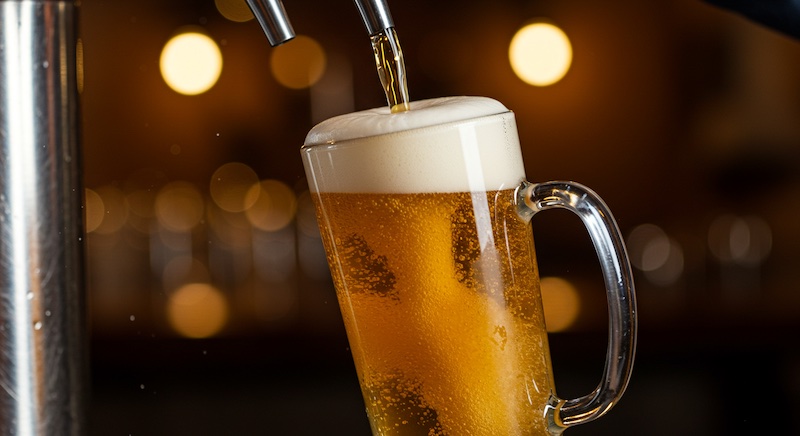
Representative Types
- Draft Beer (Nama Biiru)
Beer served fresh from the keg into a chilled mug. This is the quintessential Izakaya beer experience, with both the mug and the beer served ice-cold. - Bottled Beer (Bin Biiru)
Beer that comes in a bottle. Often shared among groups.
Most beers served in Izakayas are lagers, known for their clean, crisp finish and refreshing smoothness.
However, an increasing number of establishments now offer craft beers with unique and interesting flavors.
Basic Ways to Enjoy
The fundamental rule is to drink it cold.
It’s served in various glasses depending on the type and the establishment, such as mugs or pilsner glasses.
The fine, creamy foam (Awa) created when pouring from the tap is also key to its deliciousness.
When pouring bottled beer for others, it’s considered polite to hold the bottle with the label facing upwards so they can see the brand and to avoid touching the glass with the bottle.
Flavor Profile
The defining characteristics are the refreshing smoothness (Nodogoshi) as it goes down and its crisp taste.
A pleasant bitterness (Nigami) cuts through the richness of dishes like karaage (Japanese fried chicken) and yakitori (grilled chicken skewers), making them a perfect pairing.
You can also enjoy the aroma (Kaori) derived from the hops.
Even with just a glass of beer, there’s a surprisingly deep world to explore.
We’ll delve into the differences between lagers and ales, the art of the “three-part pour” for the perfect head, and popular brands in future articles, so stay tuned!
2. Sake (Nihonshu / Sake): Japan’s Tradition, the Profound Blessing of Rice
Inextricably linked to Japanese culinary culture is Sake (Nihonshu), a traditional brewed alcohol (Jōzōshu) made from rice.
Its delicate flavors, which beautifully complement Japanese cuisine, continue to captivate many.
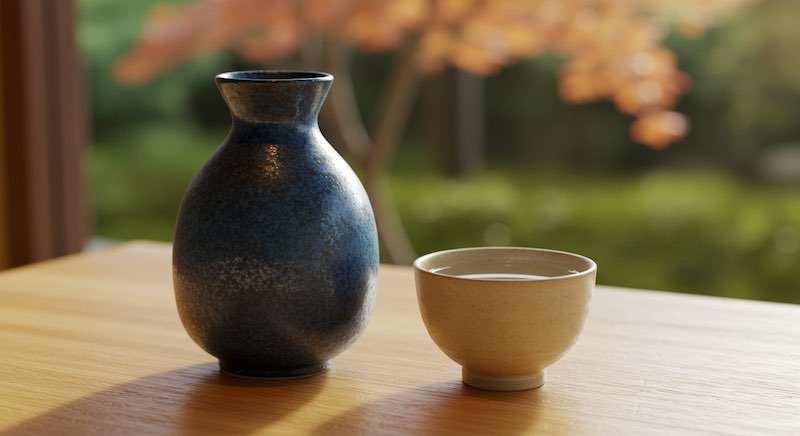
Representative Types
Sake is classified as “Special Designation Sake” (Tokutei Meishōshu) based on factors like how much the rice has been milled (Seimai Buai) and whether brewer’s alcohol has been added.
- Junmai-shu
Made only from rice, rice koji (fermented rice), and water. Enjoy the natural umami (savory taste) and rich aroma of the rice. - Ginjo-shu
Made with carefully milled rice and fermented slowly at low temperatures, characterized by a fruity and floral aroma (吟醸香, Ginjō-ka).
These are just a few examples.
There are further classifications like Daiginjo and Honjozo, which we will explore in detail in a separate article.
- For more information about sake, click here: Unlocking the Magic of Sake
Basic Ways to Enjoy
One of Sake’s greatest appeals is how its flavor changes dramatically with temperature.
- Cold Sake (Reishu) / Chilled (Hiya)
Served chilled.
There’s a range of temperatures, from “Yuki-bie” (around 5°C/41°F, snow-chilled) to “Suzu-bie” (around 15°C/59°F, cool-chilled).
Chilling tightens the aromas and creates a crisp taste.
Ginjo-shu varieties are often best enjoyed chilled. - Warm Sake (Kanzake)
Served warm.
This also has a wide temperature range, from “Hitohada-kan” (around 35°C/95°F, body temperature) to “Atsu-kan” (around 50°C/122°F, hot). Warming enhances the aroma and increases the rice’s umami and mellow flavor.
Many Junmai-shu varieties are delicious when warmed.
At an Izakaya, you can order by specifying the temperature, such as “hiya de” (chilled) or “nuru-kan de” (lukewarm).
Flavor Profile
The flavor profile ranges widely from dry (Karakuchi) to sweet (Amakuchi).
Dry sakes have a clean, crisp finish and tend to pair well with food (especially Japanese and oily dishes).
Sweet sakes are mellow, with a noticeable sweetness and umami from the rice.
Other descriptors include rich (Nōjun), light and crisp (Tanrei), and fruity, each describing the unique characteristics of different sakes.
It goes without saying that Sake pairs exquisitely with delicate Japanese cuisine like sashimi, sushi, and tempura.
The world of Sake is incredibly fascinating the more you learn.
Look forward to future articles that will delve into the detailed differences between Special Designation Sakes, how rice varieties affect flavor, the unique characteristics of regional “local sake” (Jizake), and the ultimate food pairings.
3. Shochu (Shochu): Japan’s Versatile Distilled Spirit
Alongside beer and sake, Shochu is a staple on virtually every Izakaya menu.
This distilled spirit (蒸留酒, Jōryūshu) is made from various ingredients, and its wide range of types and drinking styles makes it popular with a broad audience.
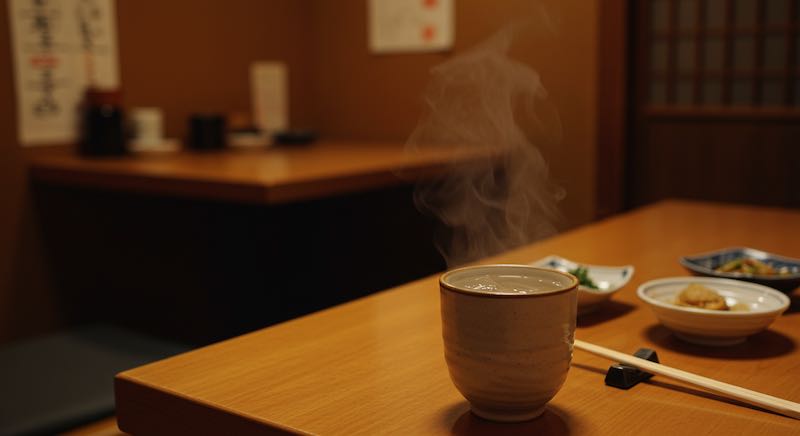
Representative Ingredients and Types
The main ingredient largely determines Shochu’s flavor.
- Imo-jochu (Sweet Potato Shochu)
Made from sweet potatoes.
Characterized by a distinct sweet and floral aroma and a rich body.
Kurokirishima is a well-known brand. - Mugi-jochu (Barley Shochu)
Made from barley. Generally less pungent, with a light and toasted flavor.
Iichiko is a representative brand. - Kome-jochu (Rice Shochu): Made from rice.
Some varieties have a ginjo-like aroma similar to sake, while others are clean and crisp.
Shiro (Hakutake Shiro) is a popular example. - Kokuto-jochu (Brown Sugar Shochu)
Made from brown sugar (limited to the Amami Islands).
Has a subtly sweet aroma and a mellow mouthfeel.
Lento is a known brand. - Others: Shochu can also be made from buckwheat (soba), perilla (shiso), and rice in the case of Awamori , a unique Okinawan specialty.
Based on the production method, Shochu is broadly divided into “Honkaku Shochu” / “Otsurui”, which retains the flavor of the ingredients, and “Korui”, which is clear and neutral in flavor. Many of the brands you see in Izakayas are Honkaku Shochu.
Representative barley shochu Kurokirisima”
Representative barley shochu “Iichiko”
Basic Ways to Enjoy
Shochu’s greatest appeal lies in its versatility.
It’s easy to find a style you enjoy.
- On the Rocks (Rock):
Poured over ice to enjoy the direct taste and aroma of the Shochu.
The changing flavors as the ice melts are also part of the experience. - With Water (Mizuwari)
Mixed with water.
This makes it milder and allows you to adjust the alcohol content, making it easier for beginners. - With Hot Water (Oyuwari)
Mixed with hot water.
This enhances the aroma of the ingredients, especially the sweet aroma of sweet potato shochu, and warms the body. - With Soda (Soda-wari)
Mixed with carbonated water.
Offers a refreshing finish and pairs well with food.
Also known as Shochu Highball (Chuhai). - Mixed with Tea (Ocha-wari)
Popular options include “Oolong High” (with oolong tea) and “Green Tea High” (with green tea).
These are refreshing and complement food well. - Maewari
A method of pre-mixing Shochu and water and letting it sit.
This results in a very mellow flavor.
Flavor Profile
The flavor varies significantly depending on the main ingredient.
Sweet potato Shochu is sweet and distinctive, barley is light and crisp, rice is clean and delicate, and brown sugar has a unique sweet aroma.
Generally, compared to Western spirits like whiskey and brandy, Shochu tends not to overpower the taste of food, making it an excellent accompaniment to meals.
The world of Shochu offers endless variety depending on the ingredients, region of origin, and distillation methods.
For those interested in learning more about Okinawan Awamori, the many unique brands, the differences between Korui and Otsurui, and even unique ways to enjoy it like “cucumber rock,” stay tuned for our in-depth articles.
4. Sour / Chuhai : Casual Fun with Colorful Refreshment
When beer or sake feels a bit heavy, or you’re looking for something more casual, Sours and Chuhai are popular choices.
These refreshing, easy-to-drink cocktail-style beverages are made by mixing a spirit like Shochu with carbonated water and various flavors.
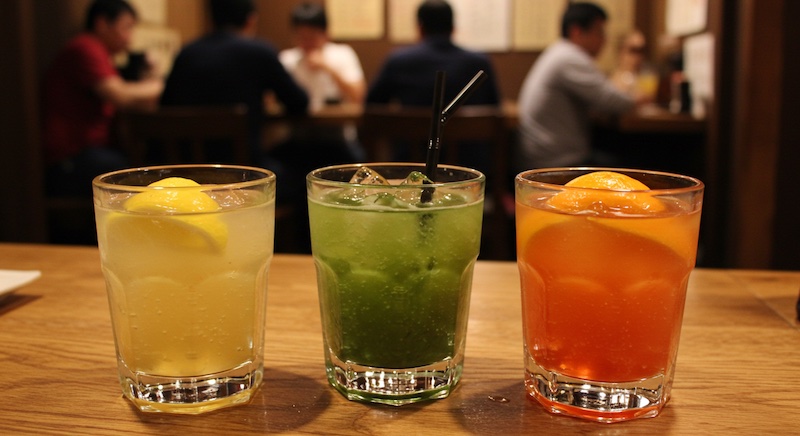
Origin and Definition
The term “Chuhai” is said to be an abbreviation of “Shochu Highball” (Shochu Haibōru).
“Sour” (Sawā) originates from the English word “sour” and initially referred to a drink made with a spirit, citrus juice, sweetener, and soda water.
Today, these two terms are often used interchangeably, with the name varying depending on the establishment.
There’s no clear legal definition. Some say that “Sour” is more common in the Kanto region (Tokyo area), while “Chuhai” is more prevalent in the Kansai region (Osaka area).
Popular Flavors
The sheer variety of flavors is a major draw!
- Lemon Sour (Remon Sawā)
The undisputed No. 1 favorite.
Its refreshing tartness pairs perfectly with fried foods.
Some places offer “freshly squeezed lemon sour” (Nama Shibori Remon Sawā). - Grapefruit Sour (Gurēpufurūtsu Sawā)
A close second to lemon.
Its subtle bitterness offers a more adult taste. - Ume (Plum) Sour (Ume Sawā)
Characterized by its sweet and sour flavor.
A great match for Japanese-style appetizers. - Calpis Sour (Karupisu Sawā)
The sweet and tangy flavor of the lactic acid drink Calpis is popular.
Can even feel like a dessert. - Others
A wide range of fruit-based flavors like peach, lychee, yuzu, grape (Kyoho), apple, and perilla (shiso) are also common.
Seasonal limited-edition flavors are another enjoyable aspect.
Visually appealing and “Instagrammable” options are also on the rise.
- For more information about Sour, click here: What Is a Sour? Japan’s Beloved Izakaya Drink
Basic Ways to Enjoy
Served cold in a glass filled with ice.
The refreshing sensation as you drink it down is irresistible.
Flavor Profile
The basic characteristics are a sweet and sour (Amazuppai) taste and the refreshing fizz (Sōkaikan) of the carbonation.
Often lower in alcohol content than beer or sake (around 3-7%), making them approachable even for those who aren’t big drinkers or are new to alcohol.
They cleanse the palate well, making them a great accompaniment to various dishes, especially fried and grilled Izakaya staples like karaage and yakitori.
The appeal of Sours and Chuhai lies in their accessibility and the vast array of flavors.
Exploring the options to find your personal favorite is part of the fun.
5. Highball (Haibōru): The New Classic! The Refreshing Appeal of Whiskey
In recent years, the Highball has rapidly established itself as a popular drink in Izakayas.
Generally a simple cocktail of whiskey mixed with soda water (carbonated water), its refreshing taste and complex flavors have garnered support from a wide range of people.
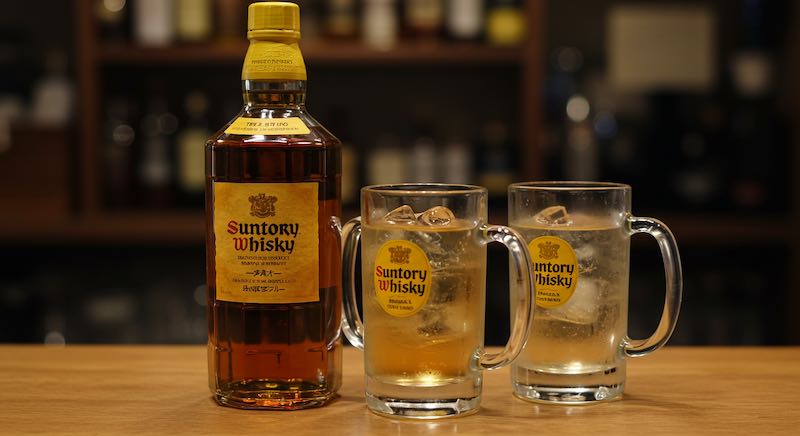
Definition and Types
While “Highball” technically refers to any spirit or liqueur mixed with a carbonated beverage, in Japanese Izakayas, simply ordering a “Highball” usually means a whiskey soda.
There are various theories about the origin of the name, including one involving a golf ball hit high in the air and another related to railway signals.
- Kaku Highball
Made with Suntory’s “Kakubin” (square bottle) whiskey, it’s considered the catalyst for the Japanese highball boom. - Jim Beam Highball
Uses Jim Beam, an American bourbon whiskey. Characterized by the distinct sweet aroma of bourbon. - Torys Highball
Made with Suntory’s “Torys” whiskey. A popular and affordable option. - Flavored Highballs
“Coke High” (mixed with Coca-Cola) and “Ginger Highball” (mixed with ginger ale) are also popular. Recently, you can also find highballs with fruit-based flavors like yuzu and grape.
Basic Ways to Enjoy
The key is to serve it ice-cold in a tall glass filled with plenty of ice.
The secret to a delicious highball is to chill the whiskey and glass well, pour the soda gently to avoid losing carbonation, and stir minimally (about once vertically).
This maximizes the refreshing fizz.
The ideal ratio of whiskey to soda is often said to be 1:3 or 1:4. A lemon slice or lemon peel garnish is a standard style.
Flavor Profile
It retains the rich aroma of whiskey while becoming very refreshing (Sōkai) and easy to drink due to the dilution with soda and the lower alcohol content.
Its clean taste pairs well with various dishes, especially fried and grilled items like karaage and yakitori.
The flavor of the highball also changes depending on the characteristics of the base whiskey (fruity, smoky, crisp, etc.).
The simple yet profound Highball continues to grow in popularity.
For those interested in exploring the differences between highballs made with various types of whiskey (Japanese, Scotch, Bourbon, etc.), the ultimate highball without ice, and unique creative highballs offered by different establishments, please look forward to our future articles.
Find Your Favorite Drink and Enjoy the Izakaya Even More!
So, we’ve introduced five popular classic drinks you’ll find in Izakayas: Beer, Sake, Shochu, Sour (Chuhai), and Highball.
- Beer
The refreshing start to any gathering. - Sake
A taste of Japanese tradition with delicate flavors that change with temperature. - Shochu
A versatile spirit with diverse ingredients and ways to enjoy. - Sour / Chuhai
Fruity and refreshing for casual enjoyment. - Highball
A new classic offering the aroma of whiskey with a crisp soda kick.
Each has its own unique appeal and offers different ways to enhance your meal and mood.
The information provided here is just the basics.
Each of these drinks has a much deeper world to explore.
Next time you visit an Izakaya, why not venture beyond your “usual” and try something new?
You might just discover your new favorite drink.
Of course, it’s important to enjoy alcohol in moderation and have fun.We hope this article helps enrich your Izakaya experience.
Stay tuned for more detailed guides on each of these drinks!
So, to your Izakaya adventures – Kanpai!
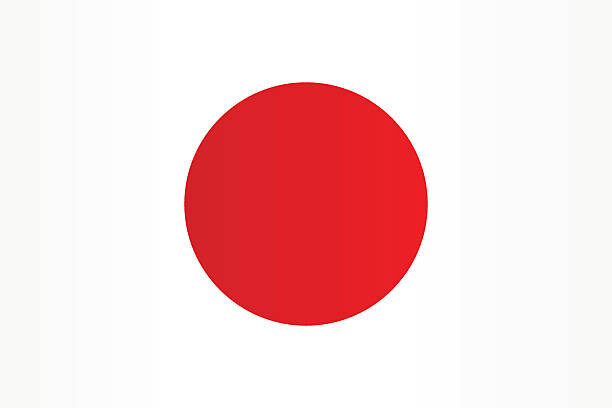


Leave a Reply